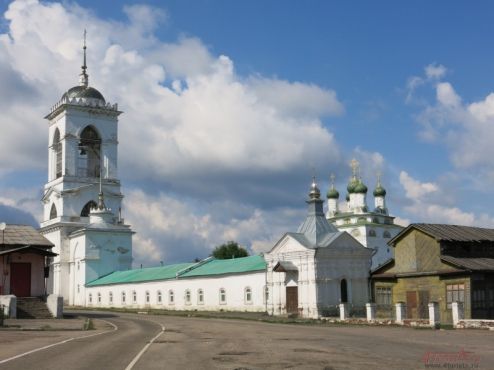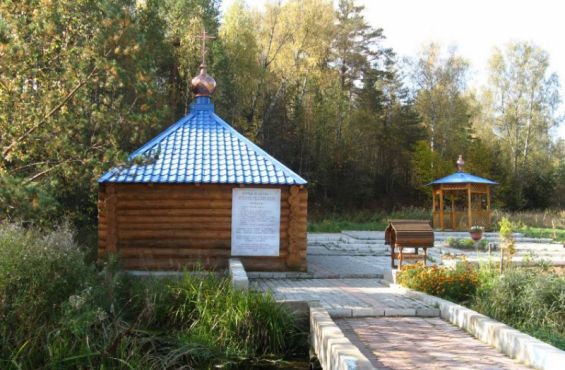Holy Epiphany Monastery
- Address:
- Vyazniki district, Mstera settlement, Leningrad Street, 10
- GPS:
- 56.37549277, 41.93970840
The Holy Epiphany (Bogoyavlensky – in Russian) Monastery in Mstera settlement (before the 19th century – Bogoyavlenskaya Sloboda) was probably founded in the early 17th century. As it was mentioned in the scribal books of the Suzdal County in 1628-1630, there already existed a stone church and "cells of black priestlings", that is, there was a monastery in Bogoyavlenskaya Sloboda, which was the patrimony of princes Romodanovsky. In 1687, on the site of an old dilapidated church, a new stone temple of the Epiphany was built. The work of local builders, serfs of princes Romodanovsky, was, apparently, supervised by an experienced and talented architect who erected a temple, similar to the famous Moscow churches of the 17th century. This was a great event for the remote village of Mstera.
The form of the temple is quite traditional: quite massive altar apses adjoined the quadrangle from the east, and a refectory – from the west. The beauty of the Epiphany Church, above all, is given by the decoration of its top. On the sloping surface of the vault, having receded from the edge, there is a row of kokoshniks (as an octagon) from which five graceful drums, also covered by kokoshniks and arcature, with miniature cupolas, "grow like a flower". The top of the facades is girded with a carved ornamental ribbon and barrel-shaped zakomars above it. Deepenings of zakomars and kokoshniks of the upper tier are painted with frescoes depicting "holy faces". This decoration of the church facades was natural: the hereditary painters of Mstera had to demonstrate their skills at the main temple of the settlement. Decorated with a bright painting and a beautiful composition of five domes, the upper part of the temple visually, as if flying up, lost its weight compared to the massive lower part standing on the ground. The decor of the temple is added with carved window frames and beautifully decorated with arches and elegant porticoes of the porches at the entrances.
Princes Romodanovsky arranged a family tomb in the refectory at the entrance of the western gate. The peasants considered the tombs as miraculous.
Next to the Epiphany Church there is a one-headed Vladimir Church (dedicated to the Vladimir Icon of the Mother of God). The time of its construction is not known exactly. But the first mention of it refers to 1734. The gate bell-tower of the monastery with five bells and clocks with fighting was first mentioned in 1710. After the spire was damaged during the hurricane of 1873, the bell tower was completely rebuilt.
In 1923, after the closing of the monastery, there was the Museum of Church Values. Since the 1950s, almost two decades the Epiphany Church was used as a warehouse.
In 1999 the Epiphany Monastery was reborn.
In 2003, the Kazan skete of the Epiphany Monastery was opened in the village of Akinshino. Here, in 1818, a stone church was built in honor of the icon of Our Lady of Kazan, which became a cultural and educational center in Akinshino. Local laird, titular councilor D.P. Priklonsky made rich deposits in it and opened a public school at the church in 1843, in which parishioners were taught to read, write and count. In the 1930s, the Kazan temple was closed and it, like most of the country's religious buildings, suffered the fate of desolation and ruin. The church closed – and life froze in the village. Then people left Akinshino at all, so the village disappeared from all modern maps.
In 2001, after the revival of the Epiphany Monastery, volunteers came in Akinshino to clear the temple and the surrounding territories. Today, the dwellers of the Kazan skete are restoring the temple. Residential buildings, a refectory and an observation deck were erected. At the foot of the hill on which the Kazan Church stands, a holy spring and a font for performing church rites have also been restored by their efforts.
The spring water is unique – rich in minerals, pure and considered holy, as it heals, refreshes and gives strength to pilgrims. There are a lot of stories about the miraculous recovery of pilgrims and wounded soldiers. The most beautiful places in Akinshino are famous for their beneficial impact on people's mental and physical health.
 Tourism portal of the
Tourism portal of the




